Physical Address
304 North Cardinal St.
Dorchester Center, MA 02124
With rare exceptions, the primary role of intraoperative consultation (IOC) during colorectal surgery is to determine the extent of disease prior to primary resection, to evaluate the adequacy of tumor resection (margin evaluation), and to diagnose unusual or unexpected intraoperative findings ( Table 11-1 ). The questions that need to be answered during IOC are usually straightforward and specific ( Table 11-2 ). As a general rule, direct communication between pathologists and surgeons is essential to achieve appropriate specimen handling, accurate gross and microscopic assessment, and timely reporting, which are important to optimal patient care. A low threshold to use deeper sections and/or to consult an experienced pathologist may help reduce sampling or interpretation errors when dealing with challenging frozen sections. Having prior biopsy or resection slides handy for comparison can also be extremely helpful in difficult cases. Finally, pathologists should be familiar with the surgical algorithm and understand the potential impact of each frozen section diagnosis. If there is any doubt about the certainty or consequence of a critical diagnosis, the pathologist should discuss it with the surgeon so that an appropriate surgical decision can be made.
| To determine the extent of disease |
| Frozen section of peritoneal nodules/implants to rule out metastasis |
| Frozen section of incidental liver nodules to rule out metastasis |
| Frozen section to look for ganglion cells for Hirschsprung disease |
| To determine the adequacy of tumor resection |
| Margin evaluation |
| Usually achieved by gross examination |
| Frozen section of distal margin for a rectal tumor |
| Frozen section of radial margin for a rectal tumor |
| Gross examination and rarely frozen section to look for tumor site in postchemoradiation or postpolypectomy specimens |
| To determine the benign or malignant nature of unusual or unexpected intraoperative findings |
| Frozen section of an unusual stricture or a masslike lesion in the setting of inflammatory bowel disease |
| Frozen section of a masslike lesion in the setting of diverticular disease |
| Frozen section of a masslike lesion in the setting of ischemic colitis |
| Frozen section of submucosal/mural lesions that do not have a preoperative diagnosis |
| Frozen section and touch preparation of an enlarged lymph node |
| Distal rectal margin: negative or positive for carcinoma? |
| Radial rectal margin: negative or positive for carcinoma? |
| Postchemoradiation or postpolypectomy tumor site evaluation: present or absent (residual tumor, scar, ulceration, or tattoo)? |
| Peritoneal nodules/implants: benign or malignant? |
| Liver nodules: benign or malignant? |
| Unusual stricture or masslike lesion in inflammatory bowel disease: benign or malignant? |
| Masslike lesion in diverticular disease: benign or malignant? |
| Masslike lesion or stricture in ischemic bowel: benign or malignant? |
| Ganglion cells in Hirschsprung disease: present or absent? |
Intraoperative consultation is commonly requested to determine the extent of disease during colorectal surgeries that are performed for neoplastic and nonneoplastic diseases. Typical examples are: 1) frozen sections of peritoneal and/or liver nodules to rule out metastasis prior to resection of a colorectal adenocarcinoma, and 2) frozen sections to look for ganglion cells in order to achieve a complete resection of aganglionic bowel in Hirschsprung disease.
Peritoneal seeding of adenocarcinomatous cells, which may lead to peritoneal carcinomatosis, is reported in 3% to 28% of colorectal cancer cases in various studies. It is often unexpectedly encountered during surgery (Koppe et al, 2006; Klaver et al, 2013). The surgeon may choose to abort the planed primary resection if it is confirmed by frozen sections because peritoneal metastasis is generally regarded as a terminal condition and usually associated with poor patient survival (Klaver et al, 2013). However, the current trend appears to advocate combined cytoreductive surgery and intraperitoneal chemotherapy, depending on tumor burden. This latter approach may offer a chance for longer survival in selected patients (Koppe et al, 2006; Weber et al, 2012; Vaira et al, 2010). For patients with severe symptoms such as bleeding and obstruction, a primary resection or bypass may still be required despite the presence of peritoneal metastasis.
Therefore the surgeon will routinely inspect the entire peritoneal surface, including the serosal surface of pelvic organs and omentum, to search for nodular lesions prior to primary resection. Tumor implants are typically white, firm, and smaller than 1 cm, which can be single or multiple. The biopsy samples received for frozen sections are usually tiny and require careful handling. Microscopically, metastatic colorectal adenocarcinoma typically displays well-formed glands with cribriform areas. The tumor cells lining the glandular structures are usually columnar and stratified. Goblet cells may be present. Mitotic figures and apoptotic bodies may be readily identifiable. The tumor glands are often filled with necrotic debris (so-called “dirty necrosis”), which is a relatively unique histologic feature of colorectal adenocarcinoma ( Figure 11-1 ) (Fleming et al, 2012). Some tumors may show mucin production, which can be copious (mucinous adenocarcinoma). If a frozen section shows only acellular mucin without recognizable tumor cells, multiple sections should be examined because tumor cells may be sparse and may show up on deeper sections ( Figure 11-2 ). A poorly differentiated carcinoma shows solid sheets or nests of tumor cells without overt glandular formation. Single individual tumor cells or signet-ring cells may be seen. Characteristically, these cells exhibit hyperchromatic nuclei with a high nucleocytoplasmic ratio and usually show an infiltrative pattern in a desmoplastic or inflammatory background ( Figure 11-3 ). Intracytoplasmic mucin vacuoles may be present.
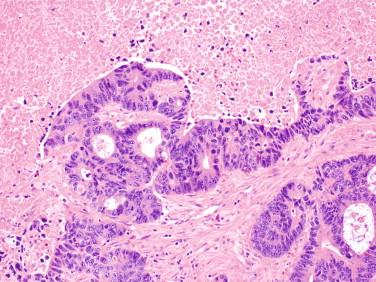
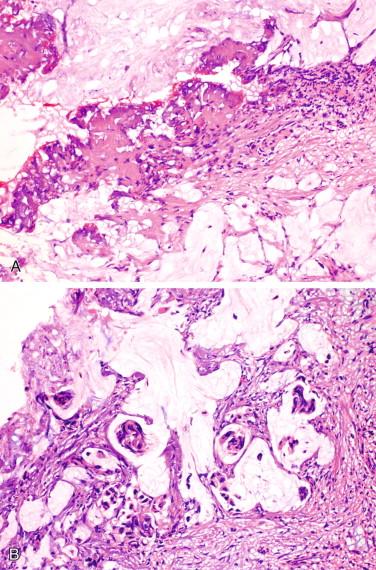
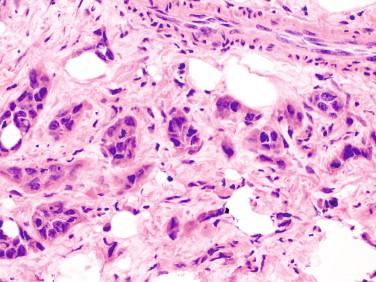
Differential diagnosis may include a wide spectrum of nonneoplastic and neoplastic conditions such as nodular mesothelial hyperplasia, mesothelial inclusion cyst, adenomatoid tumor, localized fat necrosis including infarcted epiploic appendages, fibrosis or localized fibrous tumor, calcified fibrous nodules, localized inflammation rich in lymphocytes and histiocytes, granulomas, endometriosis, endosalpingiosis, ectopic decidual reaction, splenosis, implants of borderline serous tumor of the ovary, mesothelioma, and disseminated leiomyomatosis. Distinction from metastatic colorectal adenocarcinoma is usually straightforward for most of these lesions based on histologic findings and clinical history ( Tables 11-3 and 11-4 ), but the lesions that can form glandular structures may sometimes cause diagnostic confusions.
| Clinical: Is there a history of other types of malignancy in addition to colorectal carcinoma? |
| Gross: Is a firm nodule or area present? |
| Specimen handling: Submit the entire biopsy for frozen section. |
| Sample the nodular or firm area for frozen section if the specimen is too large. |
| Microscopy at x40: Are glandular or cystic structures present? |
| Are solid clusters/sheets of cells present? |
| Is there desmoplasia, fibrosis or hyalinization? |
| Is there an infiltrative growth pattern? |
| Can nuclear atypia be seen? |
| Is there any luminal necrosis or fat necrosis? |
| Is extracellular mucin present? |
| Are inflammatory cells present? |
| Is there hemorrhage? |
| Does it look like endometriosis with stromal cells? |
| Are psammoma bodies or dystrophic calcifications present? |
| Can mesothelial cells be recognized? |
| Are foreign bodies present? |
| Are granulomas present? |
| Microscopy at x100 or higher: Are infiltrative individual cells or signet-ring cells present? |
| Can nuclear atypia be seen? |
| Are there mitotic figures including abnormal mitosis? |
| Are epithelial cells forming glands or ciliated? |
| Are there any cells in mucin pools? |
| Is intracellular mucin present? |
| Are hemosiderin granules or other pigments present? |
| Are spindly stromal cells present around glands? |
| Benign | Malignant | |
|---|---|---|
| Fat necrosis | +++ | |
| Glandular structures present | + | +++ |
| Solid sheets or clusters of atypical cells | + | +++ |
| Infiltrating individual or signet-ring cells | +++ | |
| Intracellular and/or extracellular mucin | + | +++ |
| Inflammatory cells | ++ | + |
| Spindle stromal cells around glands | ++ | + |
| Hemorrhage and hemosiderin | ++ | + |
| Ciliated epithelium | ++ | + |
| Foreign bodies | +++ | |
| Granulomas | ++ | + |
| Psammoma bodies | ++ | + |
| Dystrophic calcifications | ++ | + |
Mesothelial hyperplasia is a common reactive condition in response to a variety of peritoneal irritants such as inflammation and chronic effusion (Daya and McCaughey, 1991), which may be observed intraoperatively as single or multiple small peritoneal nodules. Histologically, mesothelial hyperplasia may show papillary projections, tubular formation, solid nests, or even individual cells in fibrous tissue simulating stromal invasion ( Figure 11-4 ). Hyperplastic mesothelial cells usually contain abundant eosinophilic or clear cytoplasm and may have cytoplasmic vacuoles. Multinucleation, mild nuclear atypia, mitotic figures, and psammoma bodies may be seen. When present as individual cells in the fibrous stroma, the cells tend to be linear in arrangement and parallel to the peritoneal surface.
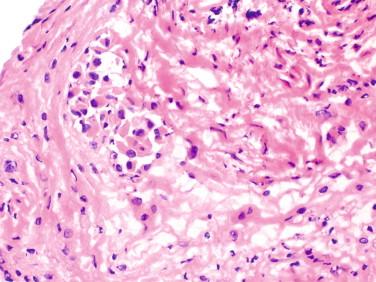
Peritoneal inclusion cysts occur over a wide age range but are predominantly seen in reproductive-aged women (Veldhuis et al, 2013). The cyst can be single or multiple and is typically small, unilocular, thin-walled, and translucent. The cyst content can be watery, serosanguineous, or gelatinous. Histologically, the cyst is lined by a single layer of flattened or cuboidal mesothelial cells on a loose fibrous stroma that may contain scattered inflammatory cells. The benign nature of the lesion should be easily determined by its simple cystic architecture and bland cytology.
However, peritoneal inclusion cysts can be multilocular, which can be large in size to form a mass lesion and to cause clinical symptoms. Multilocular peritoneal inclusion cysts are usually found in the pelvis, including the surfaces of pelvic organs (Dzieniecka and Kałużyński, 2011). This lesion is also known as benign multicystic peritoneal mesothelioma. It is believed to be probably a reactive condition, although a high recurrence rate has been observed after surgical resection (Ross et al, 1989). Histologically, the lesion shows multiple variable-sized cysts separated by fibrovascular septa. The mesothelial cells lining the cystic spaces are similar to those seen in unilocular cysts but may show small papillae, focal cribriform pattern, and squamous metaplasia.
An adenomatoid tumor is a benign neoplasm of mesothelial origin, which can rarely arise in the extragenital peritoneum such as the mesocolon, small bowel mesentery, omentum, and liver (Yeh et al, 2008; Hayes et al, 2007; Ruiz-Tovar et al, 2011). Similar to that seen in the male and female genital tracts, this tumor is usually small, but large sizes up to 8 cm have been reported (Yeh et al, 2008). Peritoneal adenomatoid tumor also tends to be multiple. The tumor is often yellow, firm, solid, or microcystic on gross examination. Microscopically, the tumor is nonencapsulated, well-circumscribed or focally infiltrative, and composed of tubules, anastomosing channels, and sievelike spaces lined by cuboidal or flattened cells ( Figure 11-5 ). These cells may also form irregular solid aggregates. There is no or minimal nuclear atypia. Mitotic figures are typically sparse or absent. Smooth muscle fibers are often present within the tumor, which can be prominent in some cases to obscure the true nature of the tumor. Histologic diagnosis of this lesion on frozen section can be very challenging and may be confused with other tumors such as lymphovascular neoplasm and metastatic carcinoma (Hayes et al, 2007; Bisceglia et al, 2009). However, adenomatoid tumor should not be easily confused with metastatic colorectal adenocarcinoma because of its bland histologic features. Comparison with prior endoscopic biopsy that shows colorectal adenocarcinoma, if available, should further help determine the benign nature of the lesion on the peritoneum.
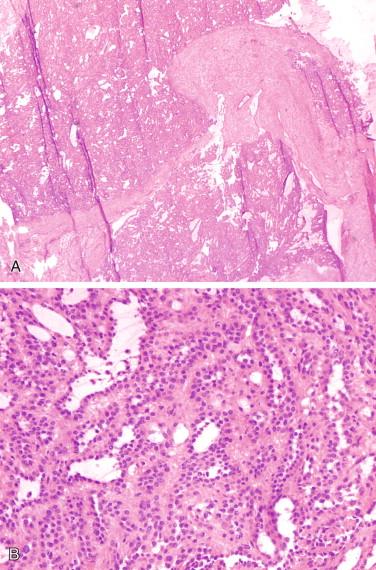
In female patients, endometriosis is always in the differential diagnosis. It affects 6% to 10% of women of reproductive age and is most commonly seen on the pelvic peritoneum (Giudice, 2010). The lesions may be red, black, blue, brown, yellow, or white, depending on their duration and relation to the peritoneal surface (superficial or deep). They are usually punctate, puckered, nodular, or cystic. An endometriotic cyst may contain chocolate-colored content (chocolate cyst) because of old hemorrhage. In classic cases, endometriosis consists of endometrial glands surrounded by endometrial stroma, which are recognizable on low-power view. The glands are lined by a single layer of epithelial cells that are typically tall with elongated nuclei and cilia and may show histologic features resembling inactive, proliferative, or secretory endometrium. The stromal cells are small, spindle-shaped, and with inconspicuous cytoplasm and may show varying degrees of decidualization. Hemosiderin, hemosiderin-laden macrophages, and pseudoxanthoma cells (hemofuscin-laden macrophages) may be prominent. The distinction between endometriosis and metastatic colorectal adenocarcinoma is usually not a problem given the characteristic histologic features of each lesion ( Figure 11-6 ). However, one needs to be aware that malignant transformation can occur rarely in peritoneal endometriotic lesions (Marchand et al, 2013; Banz et al, 2009).
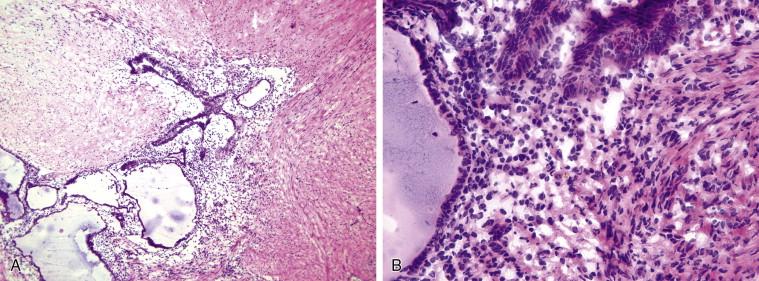
Endosalpingiosis is also seen in female patients, commonly on the pelvic peritoneum. Microscopically, it consists of single or multiple simple glands lined by a single layer of tall, ciliated epithelial cells resembling those of a normal fallopian tube. In contrast to endometriosis, endosalpingiosis does not have endometrial stroma. Pigmented macrophages and hemosiderin are typically absent. The distinction from metastatic colorectal adenocarcinoma is usually not an issue intraoperatively because most lesions of endosalpingiosis are microscopic and thus inapparent on gross inspection. However, larger lesions may become visible as tiny, white to yellow bumps or fluid-filled cysts on the peritoneal surface. Only rarely may a tumorlike lesion be seen due to florid cystic endosalpingiosis (Clement and Young, 1999; Patonay et al, 2011; Liang et al, 2007). In that case, the differentials should also include borderline serous tumor.
Become a Clinical Tree membership for Full access and enjoy Unlimited articles
If you are a member. Log in here